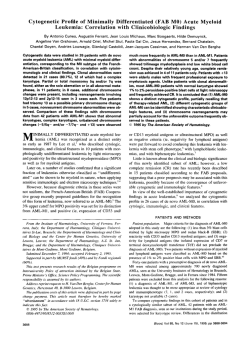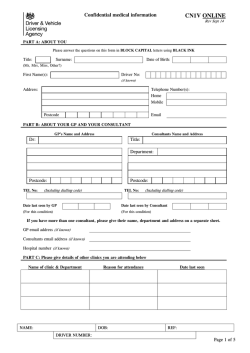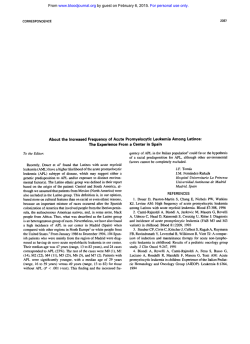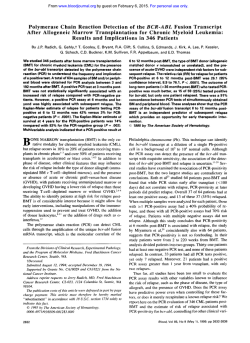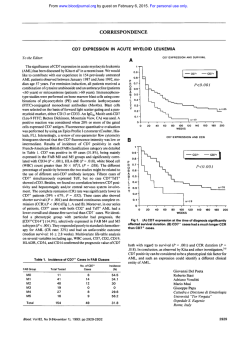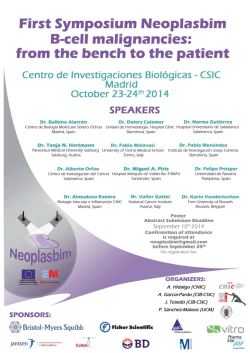
Cytogenetic studies in acute leukemia patients
Cancer Genetics and Cytogenetics 198 (2010) 135e143 Cytogenetic studies in acute leukemia patients relapsing after allogeneic stem cell transplantation Martin Schmidt-Hiebera,*, Igor W. Blaua, Gregor Richtera, Seval Tu¨rkmenb, Christiane Bommerb, Gundula Thielc, Heidemarie Neitzeld, Andrea Strouxe, Lutz Uhareka, Eckhard Thiela, Olga Blaua a Medical Department III (Hematology, Oncology and Transfusion Medicine), Charite´ Campus Benjamin Franklin, Hindenburgdamm 30, 12200 Berlin, Germany b Institute for Medical Genetics, Charite´ Campus Virchow Klinikum, Augustenburger Platz 1, 13353 Berlin, Germany c Practice for Human Genetics, Friedrichstrasse 147, 10117 Berlin, Germany d Institute for Human Genetics, Charite´ Campus Virchow Klinikum, Augustenburger Platz 1, 13353 Berlin, Germany e Institute for Biometry and Clinical Epidemiology, Charite´ Campus Benjamin Franklin, Hindenburgdamm 30, 12200 Berlin, Germany Received 11 August 2009; received in revised form 4 January 2010; accepted 12 January 2010 Abstract We analyzed karyotype stability in 22 patients with acute leukemia at relapse or disease progression after allogeneic stem cell transplantation (allo-SCT). Karyotypes before and at relapse after alloSCT were different in 15 patients (68%), the most frequent type being clonal evolution either alone or combined with clonal devolution (13 patients). Patients with and without a karyotype change did not differ significantly in overall survival (OS) (median, 399 vs. 452 days; P 5 0.889) and survival after relapse (median, 120 vs. 370 days; P 5 0.923). However, acquisition of additional structural chromosome 1 abnormalities at relapse after allo-SCT occurred more frequently than expected and was associated with reduced OS (median, 125 vs. 478 days; P 5 0.008) and shorter survival after relapse (median, 37 vs. 370 days; P 5 0.002). We identified a previously undescribed clonal evolution involving t(15;17) without PML-RARA rearrangement in an AML patient. We conclude that a karyotype change is common at relapse after allo-SCT in acute leukemia patients. Moreover, our data suggest that additional structural chromosome 1 abnormalities are overrepresented at relapse after allo-SCT in these patients and, in contrast to a karyotype change per se, are associated with reduced OS and shorter survival after relapse. Ó 2010 Elsevier Inc. All rights reserved. 1. Introduction Allogeneic stem cell transplantation (allo-SCT) is a potentially curative treatment approach for otherwise incurable diseases, including acute and chronic leukemias. However, up to 50% of patients experience relapse of their underlying malignancy [1]. Pretreatment cytogenetic characteristics are among the most important prognostic factors [2e4]. Despite ample evidence substantiating the significance of pretreatment karyotype characteristics, only a limited amount of data are available on karyotype stabilitydincluding clonal evolution patterns, their relation to the conditioning (e.g., use of total-body irradiation, TBI) and their effect on survivaldin patients who experience relapse * Corresponding author. Tel.: þ49-30-8445-4713; fax: þ49-30-84454468. E-mail address: [email protected] (M. SchmidtHieber). 0165-4608/10/$ e see front matter Ó 2010 Elsevier Inc. All rights reserved. doi:10.1016/j.cancergencyto.2010.01.005 after allo-SCT, particularly those with acute leukemia. Lawler et al. described karyotypes at relapse after alloSCT in a series of 13 patients with acute myeloid leukemia (AML) and 5 with acute lymphoblastic leukemia (ALL) and attributed clonal evolution patterns in some of them to the use of TBI for conditioning [5]. Findings obtained in another analysis indicated that chemotherapy might prolong survival in selected acute leukemia patients who experience relapse after allo-SCT; 10 patients with new cytogenetic abnormalities at relapse after allo-SCT were included [6]. Data on cytogenetic evolution patterns at relapse and also after allo-SCT have mostly been obtained in patients with chronic myeloid leukemia (CML). These investigations indicated that cytogenetic evolution patterns after allo-SCT might generally differ from those observed after conventional treatment modalities or autologous transplantation [7]. This finding was attributed partly to the clastogenic effects of the conditioning (particularly the use of 136 M. Schmidt-Hieber et al. / Cancer Genetics and Cytogenetics 198 (2010) 135e143 TBI or high-dose alkylating agents), long-term immunosuppression, and an altered bone marrow environment [8e11]. Structural chromosomal abnormalities with rearrangements probably occurring at random were prevalent in a series of 19 CML patients who experienced relapse after allo-SCT [10]. Numeric abnormalities, although not predominant in this analysis, are prevailing as major-route (e.g., þ8, þ17, or þ19) or minor-route abnormalities (e.g., þ6, þ10, or þ12) in CML patients who experience relapse after conventional treatment modalities [12]. Another study, also in CML patients, detected balanced aberrations significantly more often after allo-SCT than after autologous SCT [7]. The hypothesis that specific cytogenetic evolution patterns emerge after allo-SCT was also supported by the finding that chromosomal aberrations (e.g., inv(11)) can occur in donor cells [13]. We wished to gain more insights into cytogenetic characteristics at relapse after allo-SCT, including specific clonal evolution patterns, their relation to the conditioning (e.g., use of TBI), and their effect on mortality in acute leukemia patients. We therefore analyzed 22 patients with AML (n 5 18) or ALL (n 5 4) whose cytogenetic data were available at least from the time of initial diagnosis and posttransplantation relapse/disease progression (denoted as ‘‘relapse’’ in the following). 2. Patients and methods 2.1. Patients Patients who had AML or ALL and underwent allo-SCT at our institution (Charite´ Campus Benjamin Franklin, Berlin, Germany) between 1996 and 2007 were included in this retrospective study if cytogenetic data were available at least from the time of initial diagnosis and posttransplantation relapse. 2.2. Standard cytogenetic analyses Karyotyping was performed by the standard technique. Briefly, bone marrow or peripheral blood cells were cultured for 24 or 48 hours in RPMI 1640 medium (Biochrom AG Seromed, Berlin, Germany) supplemented with 5% fetal bovine serum (Gibco BRL, New York, NY) at 37 C in 5% CO2 without any mitotic stimulants. Chromosome analysis was performed by G banding with trypsineGiemsa (GTG). Karyotypes were classified according to the International System for Human Cytogenetic Nomenclature [14]. Karyotype stability was analyzed by comparing the karyotype at relapse after allo-SCT to that at the initial diagnosis in patients transplanted in complete remission and to that between diagnosis and allo-SCT for patients not transplanted in complete remission. In patients who underwent more than one allo-SCT or who experienced more than one relapse after transplantation, karyotype analysis refers to the first relapse after the first allo-SCT. Karyotype changes were categorized as follows: 1, identical; 2, normal to abnormal; 3, abnormal to normal; 4, clonal evolutiondmore complex karyotype at relapse than before allo-SCT (or emergence of a new clone); 5, clonal devolution (regression)dless complex karyotype at relapse than before allo-SCT (or disappearance of a previous clone); 6, clonal evolution and devolution; and 7, entirely different karyotype at both time points. 2.3. Fluorescence in situ hybridization Karyotypes were confirmed by fluorescence in situ hybridization (FISH) with specific fluorescence probes (Abbott, Wiesbaden, Germany) in all patients with chromosomal aberrations. Procedures were performed according to standard Abbott/Vysis protocols. Fluorescence signals were visualized by fluorescence microscopy with specific filters (for SpectrumAqua, SpectrumGreen, and SpectrumOrange; Abbott), and a total of 200 nuclei were counted. In two patients, complex karyotype aberrations were confirmed by performing multicolor FISH as described by the manufacturer (MetaSystems, Altlussheim, Germany). 2.4. Immunophenotyping Immunophenotyping was performed with a standard FACSscan and commercially available software (CellQuest, Becton Dickinson, Heidelberg, Germany). A particular antigen was defined as positive if fluorescence intensity exceeded that of the negative control in at least 20% of cells. 2.5. Statistical methods and definitions We wished to analyze whether involvement of a particular chromosome in additional structural abnormalities acquired at relapse after allo-SCT was random or nonrandom. For this purpose, we examined the null hypothesis that the number of breaks per chromosome in relation to the total number of breaks is equal to the relative length of each chromosome. The relative length of each chromosome was obtained from Langlois et al. [15]. Calculation of overall survival (OS) was based on the time from allo-SCT until death or the last follow-up, respectively. Survival after relapse was defined as the time from relapse to death or the last follow-up, with the date of cytogenetic analysis at relapse after allo-SCT used as baseline. Survival was calculated according to the KaplaneMeier method, and the log rank test was used for confirmatory comparisons. The influence exerted on OS by the acquisition of additional structural chromosome 1 abnormalities (or a karyotype change per se) at relapse after allo-SCT was additionally confirmed by including this variable in a Cox proportional hazard model as a time-dependent covariate. Categorical data were compared by Fisher’s exact test, and the ManneWhitney U-test was used to compare M. Schmidt-Hieber et al. / Cancer Genetics and Cytogenetics 198 (2010) 135e143 continuous variables. P values of !0.05 were considered significant (two sided). Quoted confidence intervals refer to 95% boundaries (95% CI). All statistical analyses were carried out by the commercially available SPSS version 17.0 for Windows XP software (SPSS, Chicago, IL). 3. Results 3.1. Patients Patient characteristics are listed in Table 1. The analysis comprised 22 patients (AML, n 5 18; B-cell precursor ALL, n 5 4). Karyotypes before and at relapse after alloSCT were different in 15 patients (68%) and identical in 7 (32%). Patients who had a karyotype change were significantly younger than those who did not (33 vs. 57 years, P 5 0.017). Conditioning before allo-SCT was 12 Gy TBI based in 5 patients (33%) with a karyotype change and in 2 without (29%, not significant). 3.2. Clinical, cytogenetic, and immunophenotypic characteristics Tables 2 and 3 summarize karyotypes of each individual patient at different time points. Among patients with a karyotype change, the chromosome number at diagnosis/posteallo-SCT relapse was pseudodiploid in 6/6 cases (43/43%), hypodiploid in 2/4 (14/29%), hyperdiploid in 5/3 (36/21%), and both hypodiploid and hyperdiploid clones in 1/1 case (7/7%) (patient 11, Table 2, excluded; not significant for any comparison). The mean number of different clones was 2.71 at relapse after allo-SCT (standard deviation 0.51), but 1.57 (standard deviation 0.99) at the initial diagnosis (P 5 0.001). A karyotype change was observed in 14 of 19 patients (74%) with an abnormal and 1 of 3 patients (33%) with a normal karyotype at diagnosis (not significant). Karyotype changes included clonal evolution in 53.3% (eight patients), clonal devolution in 13.3% (two patients), and both clonal evolution and devolution in 33.3% (five patients). Here, the majority of karyotype changes encompassed gains or losses of structural chromosomal abnormalities (seven patients, 50%) and, to a lesser extent, numerical chromosomal changes (two patients, 14%), or both numerical and structural chromosomal changes (five patients, 36%; patient 11, Table 2, excluded). Additional structural abnormalities acquired at posteallo-SCT relapse involved mainly chromosomes 1, 3, and 4 more often than theoretically expected on the basis of their relative length, while chromosomes 2 and 9 in particular were underrepresented (Fig. 1). In particular, among the patients, a 28-year-old man with AML, FAB M2 (patient 9, Table 2), and t(7;11)(p15;p15) at diagnosis showed clonal evolution involving t(15;17)(q15~q22;q21~q25) at relapse 7 years after alloSCT. Standard induction therapy (thioguanine, cytarabine, and daunorubicin) was initiated and resulted in complete 137 Table 1 Characteristics of 22 patients Characteristic Value Age at allo-SCT (years), median (range) Male sex, n (%) Underlying malignancy, n (%) AML B-cell precursor ALL Disease stage before allo-SCT, n (%) Complete remission Other than complete remission Conditioning, n (%) Reduced intensity Fludarabine þ treosulfan FLAMSA protocola Conventional 12 Gy TBI þ 120 mg/kg cyclophosphamide Busulphan þ cyclophosphamide Nonmyeloablative (2 Gy TBI) Donor type, n (%) MRD MUD MMUDb Donor sex match, n (%) Female to male Any other combination Stem cell source, n (%)c Bone marrow Peripheral blood GvHD prophylaxis, n (%)d CSA þ MTX CSA þ MMF CSA þ MMF þ MTX CSA 49 (19e67) 16 (73) 18 (82) 4 (18) 15 (68) 7 (32) 8 (36) 3 (14) 7 (32) 1 (4) 3 (14) 5 (23) 15 (68) 2 (9) 8 (36) 14 (64) 1 (5) 20 (95) 17 3 1 1 (77) (14) (4.5) (4.5) Abbreviations: ALL, acute lymphoblastic leukemia; allo-SCT, allogeneic stem cell transplantation; AML, acute myeloid leukemia; CSA, cyclosporin; GvHD, graft-versus-host disease; MMF, mycophenolate mofetil; MMUD, mismatched unrelated donor; MRD, matched related donor; MTX, methotrexate; MUD, matched unrelated donor; TBI, total-body irradiation. a Including fludarabine, cytarabine, and amsacrine followed by 4 Gy TBI, antithymocyte globulin, and cyclophosphamide. b Including one patient with a major human leukocyte antigen (HLA) mismatch and one patient with an HLA-B and DRB1 mismatch. c Unknown in one patient. d In vivo T-cell depletion (e.g., with antithymocyte globulin) not included. remission. The patient underwent allo-SCT from his human leukocyte antigen (HLA)-identical brother after conditioning with cyclophosphamide and 12 Gy TBI. At relapse, the bone marrow aspirate showed approximately 50% blasts with a morphology similar to that found at the initial diagnosis. Immunophenotyping and cytogenetic analyses clearly confirmed relapse. The patient received one course of chemotherapy according to the Mito-FLAG protocol (mitoxantrone, fludarabine, cytarabine, and granulocyte colony-stimulating factor), which was followed by a second allo-SCT from his HLA-identical sister after conditioning with fludarabine, cytarabine, and amsacrine (FLAMSA) followed by 4 Gy TBI, antithymocyte globulin, and cyclophosphamide (reduced-intensity conditioning). At the time of presentation, the patient had been in complete remission Patient Malignancy [type of karyotype change] 1 AML (de novo) [devolution] 2 Karyotype at diagnosis Karyotype between diagnosis and allo-SCT 138 Table 2 Karyotypes, survival, and causes of death in patients with a karyotype change at relapse after allo-SCT Karyotype at relapse after allo-SCT 46,XX,t(10;11)(p15;q23)[21]/ 46,XX[2] 46,XY,t(3;21) (q26;q22)[25] 3 AML (secondary) [devolution þ evolution] 47,XY,del(13) (q12q21),þ21[22]/46,XY[8] 4 AML (de novo) [devolution] 41,XY,add(3)(q25),5, 7,t(12;17) (p10;q10),17,18, der(18)t(5;18)(q11;q31), 22[25] 5 AML (de novo) [evolution] 46,XY,t(3;6)(q26; q25)[25] 46,XY,add(1)(p36), del(9)(q22),add(12) (p13),del(13)(q12q 21),-17,þ21[18]/ 46,X,-Y,t(1;21) (p22;p11.2),t(7;7) (p15,q36), del(13)(q12q21),þ21[7] 41,XY,add(3)(p25), 5,7,t(12;17) (p10;q10),17,L18, der(18)t(5;18)(q11; q31),22[22]/ 41,XY,5,7,der(12; 17)(p10;q10),13, 16,17,der(18) t(5;18)(q11;q31), 22[3] 46,XY[25] 46,XY,t(3;21)(q26;q22)[12]/ 46,XY,t(3;21)(q26;q22), t(2;22)(p14;q11)[11] 47,XY,add(1)(p36),t(4;15) (q22;q26),del(9)(q22), del(13)(q12q21),-17, þ21,D21[8]/ 46,X,-Y,t(1;21)(p22; p11.2),t(7;7)(p15,q36), del(13)(q12q21),þ21[13]/ 46,XX[4]a 41,XY,5,7,t(12;17)(p10; q10), 13,16, 17,der(18)t(5;18)(q11;q31), 22[15]/46,XY[15] 6 AML (secondary) [evolution] 47,XY,þ21[6]/46,XY[16] 47,XYþ21[7]/46,XY[8] 7 AML (de novo) [devolution þ evolution] 46,XY[25] 8 AML (de novo)c [devolution þ evolution] 9 AML (de novo) [evolution] 45,XY,7,t(9;11) (p21;q23)[22]/ 50,XYY,7,D8, t(9;11)(q21;q23), D13,D19,D21[3] 56,XY,þ1,D3,del(5) (q13;q33),þ6,D8, D9,D11,i(14) (q10),D15,D19,D21[25] 46,XY,t(7;11) (p15;p15)[10]/ 46,XY[15] 86 279 54 Survival after relapse (days); [cause of death] 115 [relapse (CNS)] 120 [relapse] 56 [sepsis,b aGvHD] 334 576 [sepsisb] 46,XY,t(3;6)(q26;q25)[3]/ 46,XY,t(3;6)(q26;q25), der(7)t(1;7)(q21;q22)[19]/ 46,XY,t(3;6)(q26;q25), del(7)(q22)[3] 47,XY,t(1;4)(p22;q31),þ21[5]/ 46,XY,t(11;12)(p15;q13)[3]/ 46,XY[17] 45,XY,t(3;4)(p10;p10), 7,t(9;11)(p21;q23)[25] 105 42 [liver and renal failure] 195 283 [IFI] 46,XY[25] 42~45,XY,del(5)(q13q33),L7[8]/ 49,XY,þ1,del(5)(q13q33), þ6,7[1]/46,XY[1] 177 1503 [IFI] 46,XY[25] 46,XY,t(7;11)(p15;p15), t(15;17)(q15~q22) (q21~q25)[17]/46,XY[3] 61 2458 64 [relapse] 350þ M. Schmidt-Hieber et al. / Cancer Genetics and Cytogenetics 198 (2010) 135e143 46,XX[25] AML (secondary) [evolution] 46,XX,t(10;11)(p15;q23)[2]/ 54~58,XX,t(10;11) (p15;q23),inc[6]/46,XX[1] 46,XY,t(3;21) (q26;q22)[20] Time from alloSCT to relapse (days) AML (secondary) [evolution] 43,XY,t(1;6)(q21; q22),4,5, del(6)(q14),7, t(7;10)(q31;p12),add(17) (p13),add(22)(p12)[18] 46,XY[25] 11 AML (de novo) [devolution þ evolution] AML (de novo) [evolution] 47,XY,D8[2]/ 46,XY[5] 46,XX[25] 46,XY[25] 13 B-cell precursor ALL [devolution þ evolution] 94~96,XXYY,t(9;22) (q34;q11.2)x2[17]/ 46,XY[13] 46,XY[25] 14 B-cell precursor ALL [evolution] 46,XY,del(9)(p13) [15]/46,XY[10] 46,XY[25] 15 B-cell precursor ALL [evolution] 46,XY,del(9)(p13),del(13) (q13q22)[10]/46,XY[2] 46,XY[25] 12 47,XX,þ11[10]/ 46,XX[5] 43,XY,t(1;6)(q21;q22),4, 5,del(6)(q14),7,t(7;10) (q31;p12),add(17)(p13), add(22)(p12)[11]/ 43,idem,del(3)(p21)[8]// 46,XXa[6] complex aberrant (karyotype withoutD8)[25]d 47,XX,þ11[19]/ 47,XX,Ddel(11)(q22)[7]/ 46,XX[6]/46,XYa[1] 45~46,XY,der(1)t(1;1) (p36;q21),t(3;5;10) (p13;q34;p13),(6;21) (q21;q22),der(8)t(8;8) (p21;q23),t(9;22) (q34;q11.2),L9,L17[12]/ 45~46,XY,dup(1) (qter/q21::p36/qter),t(3;16) (p13;q22),der(4)add(4)(q22), t(5;14)(q35;q11.2), der(8)t(8;8) (p21;q23),t(9;22)(q34;q11.2), L9,add(10)(q24), add(11)(p11.2)L17,Dder(22) t(9;22)x2[13] 46,XY,del(9)(p13)[7]/ 46,XY,t(5;8)(q35;q12),del(9) (p13)[4]/ 46,XY,add(3) (q29),del(9)(p13)[5]/ 46,XY,t(1;5) (q21;q13),del(9) (p13),der(17)t(3;17) (p21;p12),add(17)(p12)[5]/ 46,XY[4] 46,XY,del(9) (p13),del(13)(q13q22)[14]/ 46,XY,del(9)(p13),L10,del(13) (q13q22),Dmar[2]/ 46,XY[5] 176 720þ 399 665þ 213 1660 [relapse] 255 37 [relapse] 77 22 [relapse] 259 22 [sepsis,b IFI] 139 Karyotype changes are highlighted in boldface type (at relapse/disease progression after allo-SCT in comparison to the initial diagnosis for patients transplanted in complete remission and in comparison to the karyotype between diagnosis and allo-SCT for patients not transplanted in complete remission). Abbreviations: aGvHD, acute graft-versus-host disease; ALL, acute lymphoblastic leukemia; allo-SCT, allogeneic stem cell transplantation; AML, acute myeloid leukemia; CNS, central nervous system; IFI, invasive fungal infection; þ, patient still alive; , patient dead. a Donor cells. b Sepsis of presumably bacterial origin. c This patient underwent three allogeneic transplants and displayed further clonal evolution (54,XY,del(1)(q21),þ3,del(5)(q13q33),þ6,-7,þ8,þ9,þ11,þder(14),þ19,þ21[15]/46,XX[10]) at relapse after the second allo-SCT. d Not further specified. M. Schmidt-Hieber et al. / Cancer Genetics and Cytogenetics 198 (2010) 135e143 10 M. Schmidt-Hieber et al. / Cancer Genetics and Cytogenetics 198 (2010) 135e143 140 Table 3 Karyotypes, survival and causes of death in patients who had the same karyotype before allo-SCT and at relapse thereafter Patient Malignancy Karyotypes before allo-SCT and at relapse thereafter 1 2 3 4 5 AML AML AML AML AML 6 7 AML (de novo) B-cell precursor ALL 45,XX,7[25] 46,XY[25] 46,XX[25] 41,XY(complex aberrant, hypodiploid)[25]b 45,X,X,der(1)(2pter/2p12::3q21/3q25:: 1p36/1pter),der(2)t(2;3)(p23;q25),der(4) t(3;4)(q27;p15),del(5)(q22;q34), 7,t(16;21)(p11;q22)[25] 46,XX,der(19)t(11;19)[21]/46,XX[2] 49,XY,t(2;5)(q13;q35),t(8;15) (p23;q15),der(9)t(2;9)(?;q34), del(9)(p13),þ15,þmar[20] (secondary) (de novo) (de novo) (secondary) (de novo) Time from allo-SCT to relapse (days) Survival after relapse (days) [cause of death] 82 138 63 152 437 370 [sepsisa] 16þ 24 [bacterial pneumonia] 213 [cGvHD] 150þ 82 110 300þ 12þ Abbreviations: ALL, acute lymphoblastic leukemia; allo-SCT, allogeneic stem cell transplantation; AML, acute myeloid leukemia; cGvHD, chronic graftversus-host disease; þ, patient still alive; , patient dead. a Sepsis of presumably bacterial origin. b Not further specified. relapse (37 vs. 370 days, P 5 0.002). In contrast, acquisition of additional structural abnormalities involving either chromosome 3 or 4 had no significant impact on the median survival after relapse (37 and 56 days vs. 213 and 370 days in patients without acquisition of structural abnormalities of the respective chromosome, P 5 0.714 and 0.085). The prognostic impact of additional structural chromosome 1 abnormalities is specified in Table 4 and Figure 3B. 4. Discussion Karyotype aberrations are among the most important independent factors determining the prognosis of leukemia patients receiving chemotherapy or allo-SCT [2e4]. In the 8 6 4 % without any major complications for approximately 17 months. Results of FISH analysis and immunophenotyping are exemplified by the patient with the previously undescribed clonal evolution involving t(15;17) at relapse after alloSCT (patient 9, Table 2). FISH analysis revealed a signal for the PML locus on the derivative chromosome 17 but situated distal to the signal for the RARA locus with no evidence of PML-RARA fusion or any other RARA rearrangement (Fig. 2). Absence of PML-RARA fusion gene formation was additionally confirmed by polymerase chain reaction analysis (data not shown). AML blasts expressed CD13, CD15, CD33, CD64, and CD117 at diagnosis and were negative for CD3, CD7, CD10, CD19, CD34, and HLA-DR at that time point. The immunophenotype determined at relapse after allo-SCT showed lack of CD117 expression, while the expression patterns of the other antigens were comparable to those determined at the initial diagnosis. 3.3. Mortality Tables 2 and 3 show the time from allo-SCT to relapse and the survival after relapse for each individual patient. Patients with and without a karyotype change had a median survival after relapse of 120 days (95% CI, 0e396 days) vs. 370 days (95% CI, not applicable), respectively (P 5 0.923, Fig. 3A). The median OS was 399 days (95% CI, 150e648 days) in patients with a karyotype change and 452 days (95% CI, 319e585 days) in those with the same karyotype at both time points (P 5 0.889; this comparison was also confirmed by a Cox proportional hazard model). We further analyzed the prognostic impact of additional structural abnormalities involving either chromosome 1, 3, or 4, which were in particular overrepresented at relapse after allo-SCT. The acquisition of additional chromosome 1 abnormalities had a significant effect on the median survival after 2 0 -2 1 2 3 4 5 6 7 8 9 10 11 12 13 14 15 16 17 18 19 20 21 22 x y -4 -6 Chromosome Fig. 1. Distribution of structural chromosomal abnormalities acquired at relapse after allo-SCT in patients with AML (n 5 11)* or B-cell precursor ALL (n 5 3). The figure shows the difference between the acquired additional breakpoints detected on a particular chromosome in relation to the total number of breakpoints and the theoretically expected frequency of breakpoints in relation to the chromosome’s relative length. Positive values indicate that additional breakpoints on a particular chromosome at relapse after allo-SCT were detected more frequently than expected, whereas negative values indicate that additional breakpoints were found more rarely than theoretically expected, assuming a random distribution. *Patient No. 11 (Table 2) with a complex aberrant karyotype (not specified in detail) has not been included in this analysis. Abbreviations: ALL, acute lymphoblastic leukemia; allo-SCT, allogeneic stem cell transplantation; AML, acute myeloid leukemia. M. Schmidt-Hieber et al. / Cancer Genetics and Cytogenetics 198 (2010) 135e143 Fig. 2. Clonal evolution involving chromosomes 15 and 17 in an AML (FAB M2) patient at relapse 7 years after allogeneic stem cell transplantation. At diagnosis, the patient showed t(7;11)(p15;p15) as the only cytogenetic aberration. The results of (A) standard trypsineGiemsa banding and (B) dual-color, dual-fusion FISH (RARA, green; PML, red) demonstrate chromosomal aberrations and absence of the PML-RARA fusion gene. Abbreviations: AML, acute myeloid leukemia, FISH, fluorescence in situ hybridization. current study including 22 acute leukemia patients, a karyotype change at relapse after allo-SCT was observed in 68% of cases, the most frequent type being clonal evolution, either alone or combined with clonal devolution (87% of these cases). This observation indicates that a karyotype change in acute leukemia patients who experience relapse after allo-SCT occurs within the same range as in patients with AML (38e62%) or ALL (31e76%) who experience relapse after conventional treatment modalities [16e20]. In our analysis, patients with a karyotype change were significantly younger than those with a stable karyotype. This finding, which has previously been described in ALL patients, might be explained by the age-related diversity in clonal susceptibility of leukemic cells [21]. Previous cytogenetic studies, which were mainly performed in CML patients, suggested that clonal evolution patterns after allo-SCT are basically different from those found after conventional treatment modalities as a result of clastogenic effects of the conditioning (e.g., use of 141 TBI), immunosuppression, or an altered bone marrow environment [7,11]. To gain more insights into specific clonal evolution patterns in acute leukemia patients who experienced relapse after allo-SCT, we analyzed the distribution of structural chromosomal abnormalities acquired after allo-SCT in comparison to the theoretically expected involvement of each chromosome, assuming a random distribution. Structural abnormalities acquired after allo-SCT involved in particular chromosomes 1, 3, and 4 more often than expected, whereas mainly chromosomes 2 and 9 were underrepresented. Theoretically, overinvolvement of a particular chromosome in cytogenetic evolution patterns might be explained by the acquisition of novel structural abnormalities associated with relapse/disease progression (e.g., loss of a tumor suppressor gene) or by the fact that a particular region of the genome is more sensitive to chromosomal damage than other regions (e.g., due to clastogenic effects of the conditioning). Chase et al. found that CML patients who experienced relapse or persistent disease after alloSCT showed overinvolvement of chromosomes 1, 7, and 13 in major clones [22]. The authors concluded from their data that the 13q12~q14 region might harbor one or more tumor suppressor genes. However, overinvolvement of chromosome 13 could not be confirmed by two other studies that also examined CML patients who experienced relapse after allo-SCT [8,9]. In our series of acute leukemia patients, chromosome 13 was underrepresented rather than overinvolved. Karyotypes tended to be hypodiploid and were significantly more often polyclonal at relapse than at the initial diagnosis. Although both characteristics have previously been attributed to allo-SCT, they have also been described in AML patients who experienced relapse after conventional treatment modalities [20]. We identified a hitherto undescribed clonal evolution involving t(15;17) without PML-RARA rearrangement at relapse 7 years after allo-SCT in an AML patient (FAB M2). Translocation (15;17)(q22;q21) with PML-RARA fusion gene formation is typically restricted to acute promyelocytic leukemia and FAB M3 morphology [23]. However, only a very few case reports describe t(15;17) with or without PML-RARA fusion gene formation in AML patients with FAB types other than M3, and there are no reports on clonal evolution involving this translocation [24e27]. Immunophenotyping has 100% sensitivity and 99% specificity in predicting PML-RARA rearrangement with a highly characteristic expression pattern of CD13þ, CD15þ, and CD34þ [27]. The immunophenotype after allo-SCT relapse was CD13þCD15þ and CD34 in our patient with clonal evolution involving t(15;17) and thus differed from that typically associated with PMLRARA rearrangement. The immunophenotype determined at relapse after allo-SCT in the presented case revealed expression of CD13 and CD33, while blasts were negative for CD34, HLA-DR, and CD117 at this time point. Comparable expression patterns of antigens are frequently 142 M. Schmidt-Hieber et al. / Cancer Genetics and Cytogenetics 198 (2010) 135e143 Fig. 3. (A) Survival after relapse of patients with AML (n 5 18) or B-cell precursor ALL (n 5 4) who showed a karyotype change at relapse after allo-SCT (n 5 15; dotted line) in comparison to those who showed an identical karyotype at both time points (n 5 7; continuous line). (B) Survival after relapse in acute leukemia patients* who acquired an additional structural chromosome 1 abnormality at relapse after allo-SCT (n 5 4; dotted line) in comparison to those who did not (n 5 17, continuous line). *Patient No. 11 (Table 2) with a complex aberrant karyotype, not specified in detail has not been included in this analysis. Abbreviations: ALL, acute lymphoblastic leukemia; allo-SCT, allogeneic stem cell transplantation; AML, acute myeloid leukemia. observed in patients with FAB M3 and PML-RARA fusion gene formation [28]. It still remains unclear whether a karyotype change per se confers a negative prognosis in acute leukemia patients who experience relapse after conventional treatment modalities [17,18,20]. Noteworthy is the fact that in our analysis, a karyotype change per se did not have a negative effect on the median OS and survival after relapse. However, acquisition of an additional structural chromosome 1 abnormality at relapse after allo-SCT was associated with a significantly shorter OS, survival after relapse, and time from relapse to relapse-related death. Additional structural chromosome 1 abnormalities were clustered at the 1q21 region in three patients, whereas the 1p36 locus was involved in one patient. Abnormalities in both these regions might be associated with the pathogenesis of various hematological and oncological malignancies (e.g., through loss of a tumor suppressor gene such as KIF1Bb) and might also negatively affect prognostic impact on some malignancies [29e31]: Maru et al. found that loss of chromosome 1q is a frequent finding in esophageal cancer and that loss of the 1q21.3 region is associated with shorter OS [30]. Fonseca et al. described in a cohort of 159 multiple myeloma patients that 1q21 copy number gain and increased expression of CKS1B is significantly associated with reduced survival [31]. Acquisition of additional structural abnormalities involving chromosomes 3 or 4, which were also overinvolved beside chromosome 1 at relapse in our analysis, had a minor effect on the survival after relapse, although statistical significance might not have been reached as a result of the small sample size. We conclude that a karyotype change, particularly clonal evolution, is common at relapse after allo-SCT in acute leukemia patients. Our analysis further suggests that additional chromosome 1 abnormalities are overrepresented at relapse after allo-SCT in acute leukemia patients and, in contrast to a karyotype change per se, are associated with an inferior prognosis. A prospective study should be designed on the basis of our data to further analyze the occurrence of specific chromosomal patterns in this setting and to assess their Table 4 Prognostic effect of additional structural chromosome 1 abnormalities acquired at relapse after allo-SCT in patients with AML (n 5 17)a or B-cell precursor ALL (n 5 4) Survival Overall survivalb Time from allo-SCT to relapse-related deathb Survival after relapse Time from relapse to relapse-related death Patients who acquired an additional structural chromosome 1 abnormality at relapse after allo-SCT (n 5 4) Patients who did not acquire an additional structural chromosome 1 abnormality at relapse after allo-SCT (n 5 17) 125 (78e172) 37 (10e64) 478 (0e983) 1660 (NA) 37 (17e57) 37 (10e64) 370 (126e614) 1660 (NA) P-value 0.008 0.008 0.002 !0.001 Data are expressed as median (days) with 95% CI interval (KaplaneMeier method). Abbreviations: ALL, acute lymphoblastic leukemia; allo-SCT, allogeneic stem cell transplantation; AML, acute myeloid leukemia; 95% CI, 95% confidence interval; NA, not applicable. a Patient 11 (Table 2) with a complex aberrant karyotype (not specified in detail) has not been included in this analysis. b These comparisons have been confirmed by a Cox proportional hazard model (hazard ratios 6.9 and 23.0, 95% CI intervals 1.7e28.5 and 2.2e233.9); the median survival has been calculated by the KaplaneMeier method and P-value by Cox proportional hazard model. M. Schmidt-Hieber et al. / Cancer Genetics and Cytogenetics 198 (2010) 135e143 prognostic effect together with other important variables such as initial cytogenetics, age, and molecular characteristics. Acknowledgment We thank Dr. J. Weirowski for critical reading of the manuscript. References [1] Schetelig J, Bornha¨user M, Schmid C, Hertenstein B, Schwerdtfeger R, Martin H, Stelljes M, Hegenbart U, Scha¨ferEckart K, Fu¨ssel M, Wiedemann B, Thiede C, Kienast J, Baurmann H, Ganser A, Kolb HJ, Ehninger G. Matched unrelated or matched sibling donors result in comparable survival after allogeneic stem-cell transplantation in elderly patients with acute myeloid leukemia: a report from the Cooperative German Transplant Study Group. J Clin Oncol 2008;26:5183e91. [2] Mro´zek K, Heerema NA, Bloomfield CD. Cytogenetics in acute leukemia. Blood Rev 2004;18:115e36. [3] Van Den Neste E, Robin V, Francart J, Hagemeijer A, Stul M, Vandenberghe P, Delannoy A, Sonet A, Deneys V, Costantini S, Ferrant A, Robert A, Michaux L. Chromosomal translocations independently predict treatment failure, treatment-free survival and overall survival in B-cell chronic lymphocytic leukemia patients treated with cladribine. Leukemia 2007;21:1715e22. [4] Pullarkat V, Slovak ML, Kopecky KJ, Forman SJ, Appelbaum FR. Impact of cytogenetics on the outcome of adult acute lymphoblastic leukemia: results of Southwest Oncology Group 9400 study. Blood 2008;111:2563e72. [5] Lawler SD, Khokhar MT, Davies H, Williams GJ, Powles R. Cytogenetic studies of leukemic recurrence in recipients of bone marrow allografts. Cancer Genet Cytogenet 1990;47:249e63. [6] Frassoni F, Barrett AJ, Gran˜ena A, Ernst P, Garthon G, Kolb HJ, Prentice HG, Vernant JP, Zwaan FE, Gratwohl A. Relapse after allogeneic bone marrow transplantation for acute leukaemia: a survey by the EBMT of 117 cases. Br J Haematol 1988;70:317e20. [7] Karrman K, Sallerfors B, Lenhoff S, Fioretos T, Johansson B. Cytogenetic evolution patterns in CML post-SCT. Bone Marrow Transplant 2007;39:165e71. [8] Alimena G, De Cuia MR, Mecucci C, Arcese W, Mauro F, Screnci M, Mancini M, Cedrone M, Nanni M, Montefusco E, Mandelli F. Cytogenetic follow-up after allogeneic bone-marrow transplantation for Ph1-positive chronic myelogenous leukemia. Bone Marrow Transplant 1990;5:119e27. [9] Offit K, Burns JP, Cunningham I, Jhanwar SC, Black P, Kernan NA, O’Reilly RJ, Chaganti RS. Cytogenetic analysis of chimerism and leukemia relapse in chronic myelogenous leukemia patients after T celledepleted bone marrow transplantation. Blood 1990;75:1346e55. [10] Shah NK, Wagner J, Santos G, Griffin CA. Karyotype at relapse following allogeneic bone marrow transplantation for chronic myelogenous leukemia. Cancer Genet Cytogenet 1992;61:183e92. [11] Yoshihara T, Hibi S, Yamane Y, Morimoto A, Hashida T, Iwami H, Tsunamoto K, Imashuku S. Numerous nonclonal chromosomal aberrations arising in residual recipient hematopoietic cells following allogeneic bone marrow transplantation. Bone Marrow Transplant 2005;35:587e9. [12] Johansson B, Fioretos T, Mitelman F. Cytogenetic and molecular genetic evolution of chronic myeloid leukemia. Acta Haematol 2002;107:76e94. [13] Medeiros BC, Chun K, Kamel-Reid S, Lipton J. Inv (11) (p15q21) in donor-derived Ph-negative cells in a patient with chronic myeloid leukemia in relapse successfully treated with imatinib mesylate post allogeneic stem cell transplantation. Am J Hematol 2007;82:758e60. 143 [14] Shaffer LG, Tommerup N, editors. ISCN 2005: An International SYstem for Human Cytogenetic Nomenclature. Basel: S. Karger. 2005. [15] Langlois RG, Yu NC, Gray JW, Carrano AV. Quantitative karyotyping of human chromosomes by dual beam flow cytometry. Proc Natl Acad Sci USA 1982;79:7876e80. [16] Shikano T, Ishikawa Y, Ohkawa M, Hatayama Y, Nakadate H, Hatae Y, Takeda T. Karyotypic changes from initial diagnosis to relapse in childhood acute leukemia. Leukemia 1990;4:419e22. [17] Chucrallah AE, Stass SA, Huh YO, Albitar M, Kantarjian HM. Adult acute lymphoblastic leukemia at relapse. Cytogenetic, immunophenotypic, and molecular changes. Cancer 1995;76:985e91. [18] Estey E, Keating MJ, Pierce S, Stass S. Change in karyotype between diagnosis and first relapse in acute myelogenous leukemia. Leukemia 1995;9:972e6. [19] Baer MR, Stewart CC, Dodge RK, Leget G, Sule´ N, Mro´zek K, Schiffer CA, Powell BL, Kolitz JE, Moore JO, Stone RM, Davey FR, Carroll AJ, Larson RA, Bloomfield CD. High frequency of immunophenotype changes in acute myeloid leukemia at relapse: implications for residual disease detection (Cancer and Leukemia Group B Study 8361). Blood 2001;97:3574e80. [20] Kern W, Haferlach T, Schnittger S, Ludwig WD, Hiddemann W, Schoch C. Karyotype instability between diagnosis and relapse in 117 patients with acute myeloid leukemia: implications for resistance against therapy. Leukemia 2002;16:2084e91. [21] Hur M, Chang YH, Lee DS, Park MH, Cho HI. Immunophenotypic and cytogenetic changes in acute leukaemia at relapse. Clin Lab Haematol 2001;23:173e9. [22] Chase A, Pickard J, Szydlo R, Coulthard S, Goldman JM, Cross NC. Non-random involvement of chromosome 13 in patients with persistent or relapsed disease after bone-marrow transplantation for chronic myeloid leukemia. Genes Chromosomes Cancer 2000;27:278e84. [23] Grignani F, Fagioli M, Alcalay M, Longo L, Pandolci PP, Donti E, Biondi A, Lo Coco F, Grignani F, Pelicci PG. Acute promyelocytic leukemia: from genetics to treatment. Blood 1994;83:10e25. [24] Di Bona E, Montali A, Quercini N, Rossi V, Luciano A, Biondi A, Rodeghiero F. A (15;17) translocation not associated with acute promyelocytic leukaemia. Br J Haematol 1996;95:706e9. [25] Allford S, Grimwade D, Langabeer S, Duprez E, Saurin A, Chatters S, Walker H, Roberts P, Rogers J, Bain B, Patterson K, McKernan A, Freemont P, Solomon E, Burnett A, Goldstone A, Linch D. Identification of the t(15;17) in AML FAB types other than M3: evaluation of the role of molecular screening for the PML/RARalpha rearrangement in newly diagnosed AML. The Medical Research Council (MRC) Adult Leukaemia Working Party. Br J Haematol 1999;105:198e207. [26] Li S, Zhang L, Kern WF, Andrade D, Forsberg JE, Bates FR, Mulvihill JJ. Identification of t(15;17) and a segmental duplication of chromosome 11q23 in a patient with acute myeloblastic leukemia M2. Cancer Genet Cytogenet 2002;138:149e52. [27] Cotter M, Enright H. A novel t(15;17) translocation in acute myeloid leukaemia not associated with PML/RARalpha rearrangement. Clin Lab Haematol 2003;25:255e7. [28] Paietta E. Expression of cell-surface antigens in acute promyelocytic leukaemia. Best Pract Res Clin Haematol 2003;16:369e85. [29] Bagchi A, Mills AA. The quest for the 1p36 tumor suppressor. Cancer Res 2008;68:2551e6. [30] Maru DM, Luthra R, Correa AM, White-Cross J, Anandasabapathy S, Krishnan S, Guha S, Komaki R, Swisher SG, Ajani JA, Hofstetter WL, Rashid A. Frequent loss of heterozygosity of chromosome 1q in esophageal adenocarcinoma: loss of chromosome 1q21.3 is associated with shorter overall survival. Cancer 2009;115:1576e85. [31] Fonseca R, Van Wier SA, Chng WJ, Ketterling R, Lacy MQ, Dispenzieri A, Bergsagel PL, Rajkumar SV, Greipp PR, Litzow MR, Price-Troska T, Henderson KJ, Ahmann GJ, Gertz MA. Prognostic value of chromosome 1q21 gain by fluorescent in situ hybridization and increase CKS1B expression in myeloma. Leukemia 2006;20:2034e40.
© Copyright 2025

